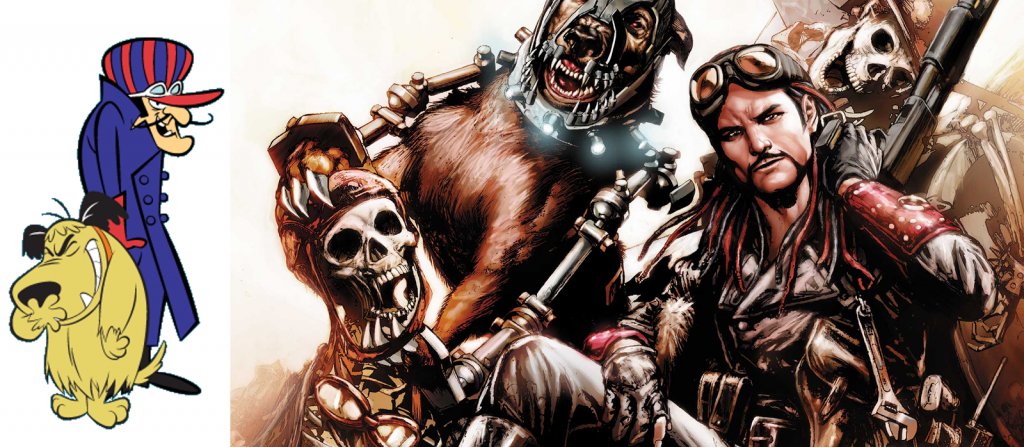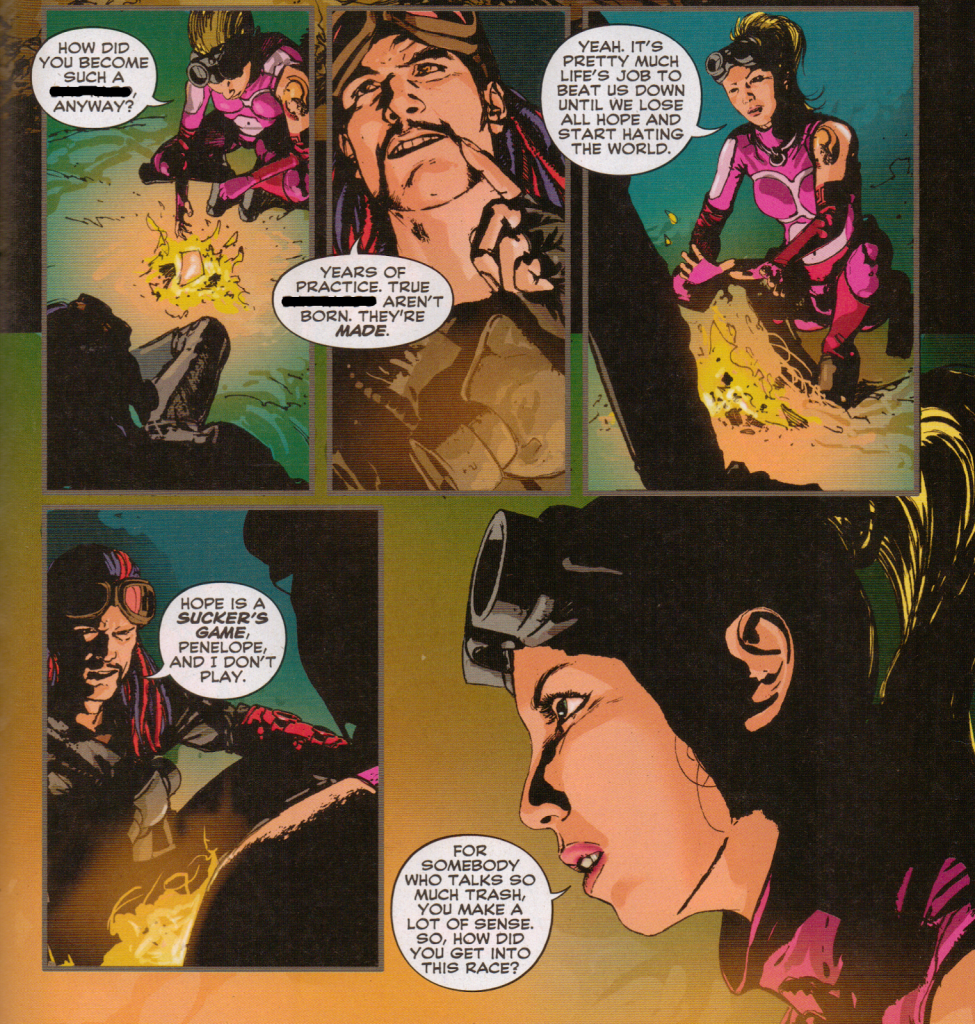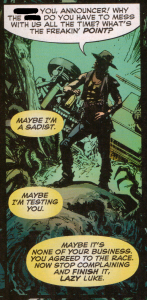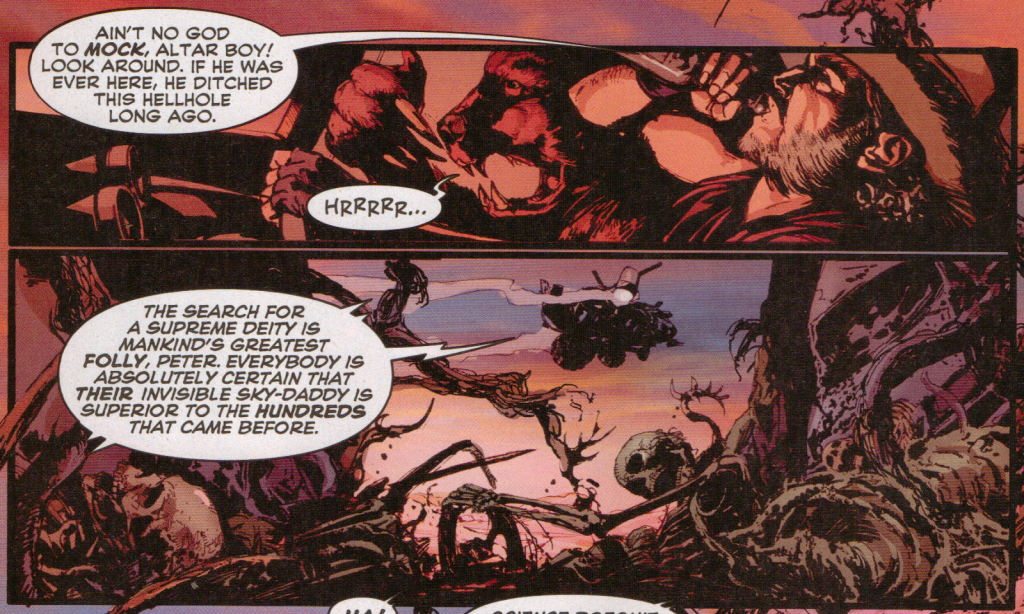 In the summer of 2016, Warner Bros decided to try and reimagine their popular Hannah-Barbera cartoon characters as more mature versions of themselves. This line included four titles: Future Quest, which united the Hannah-Barbera actions heroes on an adventure throughout space and time; The Flintstones, looking at the stone-age Honeymooners through a modern sitcom lens; Scooby Apocalypse, where the Scooby gang meets for the first time just as the world ends; and Wacky Raceland, twisting the goofy wacky racers into post-apocalyptic speed demons in a world where it’s drive or die.
In the summer of 2016, Warner Bros decided to try and reimagine their popular Hannah-Barbera cartoon characters as more mature versions of themselves. This line included four titles: Future Quest, which united the Hannah-Barbera actions heroes on an adventure throughout space and time; The Flintstones, looking at the stone-age Honeymooners through a modern sitcom lens; Scooby Apocalypse, where the Scooby gang meets for the first time just as the world ends; and Wacky Raceland, twisting the goofy wacky racers into post-apocalyptic speed demons in a world where it’s drive or die.
The old cartoon Wacky Races pitted 11 alliteratively named drivers and their impossible machines on a no-holds-barred cross-country demolition course with predictably goofy results. The new comic book looks like Mad Max meets Speed Racer. The cars now have an attitude of their own, driven by an AI that reflects, distorts, and sometimes clashes with the personality of their driver. These turbo-charged death machines are powered by self-repairing nanomachines and armed to the teeth. While the vehicles are clearly the product of advanced technology, the rest of the world struggles to survive clouds of voracious nanite swarms, monstrous leviathans, once-human mutants, and a blasted, radioactive landscape. The disembodied Announcer continually goads the racers forward with an agenda all her own.

The meat of the story is of course the conflict between the racers. Of the 11 wacky racers – and you can be forgiven if you can’t recall anyone other than Dick Dastardly and Muttley – only a few are given any kind of in-depth treatment. Each one of the racers has their own motivations for driving, not just to gain their promised ticket out of the blasted wasteland and into paradise.

Wacky Races (1968), left; Wacky Raceland (2016), right
None of these people can really be called noble or selfless – or even healthy, really. Each one of them brings their own brand of despicable to the story, leaving us with a cast of characters both fascinating and repulsive. Every one of these people is a different kind of broken, sometimes compelling, sometimes off-putting, and sometimes just annoying. The Red Baron believes the apocalypse has been sent by the gods to weed out the weak and the degenerate. The Announcer has promised both Penelope Pitstop and Dick Dastardly that she will rebuild the winner’s family from the DNA in their bones. Lazy Luke and Blubber Bear need no more motivation than the promise of a drink at the next finish line.
The first five issues of this limited series really shine. Each issue zooms in on one of the characters, sprinkling hints of their past and teasing flashbacks around the action of the current story. Tedious explanations of motivation and laborious explorations of emotional depth are blessedly absent, leaving readers to draw their own conclusions about what drives the racers and the secret behind the Announcer’s seemingly godlike control of the world. The mystery behind the apocalypse, the role of the Announcer, and the lengths to which the racers will go to keep moving forward make for fascinating and truly compelling storytelling. At it’s heart that’s what this series is really all about, the ability of people to carry on with their lives in a world that provides little to no temporal joy, that’s actively trying to kill them, and whose hope of paradise at the end is more or less a blatant lie. It’s a starkly honest view of what happens when a wholly humanistic and materialistic worldview is taken to its logical conclusion.

Writer Ken Pontac’s comic book credits are fairly slim, but he has an extensive career in film and television. He has been involved to varying degrees with some of my favorite shows over the years, including ReBoot, The Roswell Conspiracies, Sherlock Holmes in the 22nd Century, several incarnations of Sonic the Hedgehog, and Generator Rex. It is this last cartoon that seems to have left the biggest impression on Wacky Raceland, as they share a premise that Wacky Raceland cranks up to 11 and drops all pretense at being family-friendly.

And Wacky Raceland is *not* family friendly. The violence is graphically portrayed in a world that is visually disgusting. The racers use casually vulgar language and obsess over very unsubtle sexual innuendo. Sergeant Blast is now a transsexual woman who forcefully and repeatedly advocates the correctness of his choices. These elements add nothing to the story and their interjection is adolescent at best and intentionally offensive at worst.
Finally, the story really suffers for being forced into a limited series format. The final issue just kind of lumps a conclusion on top of the story structure without effectively paying off the characters or worldbuilding. Another six issues would have given things time to develop and set up a proper payoff. Another twelve would have allowed the plot time to breathe and the characters room to grow. The final issue is crammed with lazy and nonsensical plot devices that run counter to the tone set by the previous five issues. It was a disappointing conclusion to a very promising premise – not ruinous, but profoundly disappointing.
If you like the idea of Mad Max meets Speed Racer in a world full of tantalizing and mysterious secrets, if you can get past the obscene language and at times too-frenetic artwork, if you want to meet a cast of degenerates whom you won’t be able to help but love to hate – or perhaps find yourself hating to love – then Wacky Raceland is for you. But is it a book for me? Not so much. The artwork doesn’t do a good job of communicating the action to me, the language is obsessively vulgar and needlessly offensive, and the intensely serious tone of the book climaxes with a ludicrous plot twist.

It’s a shame, really. The question of life’s purpose leads to the cross, inviting us to leave the sin of this world behind for the joy of the next one. In the world of Wacky Raceland, even the stubbornly Catholic Peter Perfect is unable to hold out for the hope that the chief end of man is to glorify God and enjoy Him forever. In a world without God, Lazy Luke’s ambition to crawl into a bottle and never come out seems like the only rational response. All six issues have been collected into a trade paperback and digital editions. I give Wacky Raceland a Quality score of “High, but Flawed” and a Relevance score of “High”.
***
Winston Crutchfield has loved comics ever since he discovered his older brother’s stash of Spider-Man and What If? books forgotten in a dresser drawer. He blames his mother for teaching him to read and his grandmother for fooling nobody by “accidentally” picking up new comics at the drugstore with her crossword puzzles. He is the publisher and small business service provider at Critical Press Media, and may be found in the Christian Geek Central forums as “MindSpike”.
Last 5 posts by Winston Crutchfield
- Disney Kingdoms comics - July 7th, 2017
- Sonic the Hedgehog - June 19th, 2017
- He-Man / ThunderCats - June 5th, 2017
- Scooby Apocalypse - May 15th, 2017
- Doctor Who at Titan Comics - April 17th, 2017
